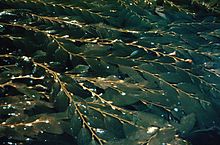
Back ظلة Arabic Полаг лесу Byelorussian পল্লববিতান Bengali/Bangla Cobricel arbori Catalan Krone (plantedel) Danish Schirm (Wald) German Kanopeo Esperanto Dosel arbóreo Spanish Võrastik Estonian تاجپوش Persian






In biology, the canopy is the aboveground portion of a plant cropping or crop, formed by the collection of individual plant crowns.[1][2][3] In forest ecology, the canopy is the upper layer or habitat zone, formed by mature tree crowns and including other biological organisms (epiphytes, lianas, arboreal animals, etc..).[4] The communities that inhabit the canopy layer are thought to be involved in maintaining forest diversity, resilience, and functioning.[5] Shade trees normally have a dense canopy that blocks light from lower growing plants.
- ^ Campbell, G.S.; Norman, J.M. (1989). "The description and measurement of plant canopy structure". In Russell, Graham; Marshall, Bruce; Jarvis, Paul G. (eds.). Plant Canopies: Their Growth, Form and Function. Cambridge University Press. pp. 1–19. doi:10.1017/CBO9780511752308.002. ISBN 978-0-521-39563-2. LCCN 87032902.
- ^ Moffett, Mark W. (December 2000). "What's "Up"? A Critical Look at the Basic Terms of Canopy Biology". Biotropica. 32 (4): 569–596. doi:10.1646/0006-3606(2000)032[0569:WSUACL]2.0.CO;2. S2CID 45947367.
- ^ Hay, Robert K.M.; Porter, John R. (2006). The Physiology of Crop Yield (Second ed.). Blackwell Publishing. ISBN 978-1-4051-0859-1. LCCN 2006005216.
- ^ Parker, Geoffrey G. (1995). "Structure and microclimate of forest canopies". In Lowman, Margaret D.; Nadkarni, Nalini M. (eds.). Forest Canopies (First ed.). Academic Press. pp. 73–106. ISBN 978-0124576506. LCCN 94041251.
- ^ Nadkarni, Nalini M. (February 1994). "Diversity of Species and Interactions in the Upper Tree Canopy of Forest Ecosystems". American Zoologist. 34 (1): 70–78. doi:10.1093/icb/34.1.70 – via Oxford Academic.